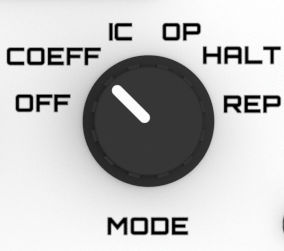Modes
An analog computer can be in different Modes, it can however be only in one mode at a time. In The Analog Thing, the modes are chosen with a switch in the upper right part of the front panel and explained in the following.
Minion Mode (MINION)
In this mode, The Analog Thing is remote-controlled by another The Analog Thing. See Daisy Chaining for details of how to use this mode. In case you don't have another Analog Thing, this mode is of no interest for you. It doesn't harm to have your Analog Thing in that mode in case nothing is connected, but don't be fooled it would be turned off -- the Voltmeter is powered off in this mode by intention.
Turned-Off Mode (OFF)
In this mode, The Analog Thing is turned off. Please always remove the Power chord in order to make sure everything is free from electricity if you want to do something crazy with the electronics. Otherwise, it is completely fine to change the program also while the computer is running.
Coefficient-Setting Mode (COEF)
This mode is all about fine tuning Coefficients/Potentiometers. See there for how to use this mode.
Initial Conditions Mode (IC)
In this mode, the integrators are charged for their Initial conditions. The yellow IC LED is glowing. This mode is helpful if you manually do a IC/OP cycle.
Operations Mode (OP)
In this mode, the analog computer is in normal operating mode. That means, the integrators are freely integrating. Depending on your application, it can be interesting to have something running for several seconds or even minutes. The green OP LED is glowing. It may occur that you immediately run into some Overflow problem, in this case the red OL LED glows.
Halting Mode (HALT)
In this mode, the analog computer is pausing the integrators. They hold their values and can be readily read off. This is useful for static analysis of the circuit, or for testing values with the Voltmeter. You can go back to Operations Mode at any time.
Repetitive Mode (REP)
In this mode, the analog computer is automatically and repeatedly switching between IC and OP mode. While the IC time is hard coded to ![]() Fill me in, the OP time can be chosen within a range of minimum
Fill me in, the OP time can be chosen within a range of minimum ![]() Fill me in and maximum
Fill me in and maximum ![]() Fill me in miliseconds with the slider called
Fill me in miliseconds with the slider called OP TIME.
Fast Repetitive Mode (REPF)
Similar to REP, but the OP times are divided by a factor ![]() Fill me in.
Fill me in.
